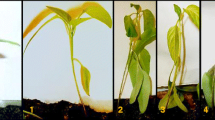Abstract
The effect of several fungicides and methods of chemical treatment on the viability of the pycnidia of Taxa 1 and 2 of Phomopsis viticola on grapevines was tested. Benomyl, fluazinam, rnancozeb, dithianon and 8-hydroxyquinoline sulphate were effective chemicals, and spraying was shown to be an effective method of application of the chemicals. The importance of these findings in reducing the carry over of inoculum from one growing season to the next is discussed.
Similar content being viewed by others
References
Cucuzza, J.D. and Sail, M.A. (1982) — Phomopsis cane and leaf spot disease of grapevine: effects of chemical treatment on inoculum level, disease severity and yield. Plant Disease 66: 794–797.
Gadoury, D. M., Pearson, R. C., Riegel, D.G., Seem, R.C., Becker, C.M. and Pscheidt, J.W. (1994) — Reduction of powdery mildew and other diseases by over-thetrellis applications of lime sulfur to dormant grapevines. Plant Disease 78: 83–87.
Malathrakis, N.E. (1989) — Effect of time of application of three eradicant fungicides on the control of dead arm of grapes. In Influence of environmental factors on the control of grape pests, diseases and weeds. Proceeding of a meeting of the E.C Expert’s Group, Thessaloniki, 6 8 Oct. 1987 (Ed R. Cavalloro), pp. 261–263; Rotterdam, Netherlands.
Merrin, S.J., Nair, N.G. and Tarran, J. (1995a) — Variation in Phomopsis recorded on grapevine in Australia and its taxonomic and biological implications. Australasian Plant pa tho logy 24: 44–56.
Merrin, S. J., Nair, N.G. and Creecy, H. (1995b) — Evaluation of fungicides for control of Phomopsis cane and leaf blight on grapevine. Fungicide and Nematicide Tests 50: 71.
Pscheidt, J.W. and Pearson, R.C. (1989) — Time of infection and control of Phomopsis fruit rot of grape. Plant Disease 73: 829–833.
Ramsdell D. C. (1995) — Evaluation of foliar fungicides for control of fruit rots, and downy mildew. Fungicide and Nematicide Tests 50: 75–76.
Taylor, R.H. and Mabbitt, J.M. (1961) — Dead-arm disease of grapevines. The Journal of Agriculture, Victoria 59: 157–165.
Author information
Authors and Affiliations
Additional information
An erratum to this article is available at http://dx.doi.org/10.1007/BF03213318.
Rights and permissions
About this article
Cite this article
Castillo-Pando, M.S., Nair, N.G., Emmett, R.W. et al. Inhibition in pycnidial viability of Phomopsis viticola on canes in situ as an aid to reducing inoculum potential of cane and leaf blight disease of grapevines. Australasian Plant Pathology 26, 21–25 (1997). https://doi.org/10.1071/AP97003
Received:
Accepted:
Issue Date:
DOI: https://doi.org/10.1071/AP97003




